2016
Exibindo questões de 201 a 300.
Uma pedra de gelo, de 1,0 kg de massa, é retirada de um - FGV 2016
Física - 2016Uma pedra de gelo, de 1,0 kg de massa, é retirada de um ambiente em que se encontrava em equilíbrio térmico a –100°C e recebe 150 kcal de uma fonte de calor. Considerando o calor específico do gelo 0,5 cal/(g.°C), o da água 1,0 cal/(g.°C), e o calor latente de fusão do gelo 80 cal/g,
Em uma das oscilações, Mariana partiu do extremo, de uma - FGV 2016
Física - 2016Em uma das oscilações, Mariana partiu do extremo, de uma altura de 80 cm acima do solo e, ao atingir a posição inferior da trajetória, chutou uma bola, de 0,5 kg de massa, que estava parada no solo. A bola adquiriu a velocidade de 24 m/s imediatamente após o chute, na direção horizontal do solo e do movimento da menina. O deslocamento de Mariana, do ponto extremo até o ponto inferior da trajetória, foi realizado sem dissipação de energia mecânica.
Para determinados tipos de pesquisa ou trabalho, cápsulas - FGV 2016
Física - 2016Para determinados tipos de pesquisa ou trabalho, cápsulas tripuladas são enviadas para as profundezas dos oceanos, mares ou lagos. Considere uma dessas cápsulas de forma cilíndrica, de 2,0 m de altura por 2,0 m de diâmetro, com sua base superior a 48 m de profundidade em água de densidade 1,0.103 kg/m3 , em equilíbrio como ilustra a figura.
Dados:A pressão atmosférica no local é de 1,0.105 Pa, e a aceleração da gravidade é de 10 m/s2. Adote π = 3.

Nesse parquinho infantil, há dois escorregadores de mesma - FGV 2016
Física - 2016O texto a seguir refere-se à questão
Criança feliz é aquela que brinca, fato mais do que comprovado na realidade do dia a dia. A brincadeira ativa, a que faz gastar energia, que traz emoção, traz também felicidade. Mariana é uma criança que foi levada por seus pais para se divertir em um parquinho infantil.
Nesse parquinho infantil, há dois escorregadores de mesma altura h relativamente ao chão. Um deles é retilíneo (R) e outro é curvilíneo (C) em forma de tobogã, como indica a figura.

A nave americana New Horizons passou, recentemente, bem - FGV 2016
Física - 2016O texto a seguir refere-se à questão
Criança feliz é aquela que brinca, fato mais do que comprovado na realidade do dia a dia. A brincadeira ativa, a que faz gastar energia, que traz emoção, traz também felicidade. Mariana é uma criança que foi levada por seus pais para se divertir em um parquinho infantil.
Inicialmente, Mariana foi se divertir no balanço. Solta, do - FGV 2016
Física - 2016O texto a seguir refere-se à questão
Criança feliz é aquela que brinca, fato mais do que comprovado na realidade do dia a dia. A brincadeira ativa, a que faz gastar energia, que traz emoção, traz também felicidade. Mariana é uma criança que foi levada por seus pais para se divertir em um parquinho infantil.
Inicialmente, Mariana foi se divertir no balanço. Solta, do repouso, de uma certa altura, ela oscilou entre dois extremos elevados, a partir dos quais iniciou o retorno até o extremo oposto. Imagine-a no extremo da direita como na figura.
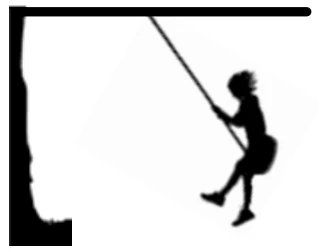
Não está longe a época em que aviões poderão voar a - FGV 2016
Física - 2016Não está longe a época em que aviões poderão voar a velocidades da ordem de grandeza da velocidade da luz (c) no vácuo.
A figura mostra o painel de instrumentos de um automóvel em - FGV 2016
Física - 2016A figura mostra o painel de instrumentos de um automóvel em movimento. Os maiores medidores são: à esquerda, o tacômetro (conta-giros do motor), e à direita, o velocímetro.
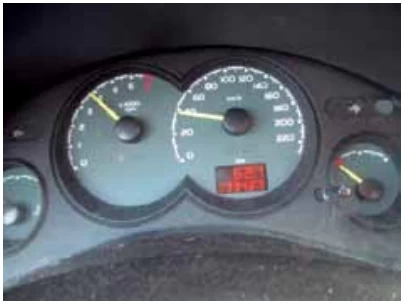
Um veículo desloca-se por uma pista horizontal, retilínea - FGV 2016
Física - 2016Um veículo desloca-se por uma pista horizontal, retilínea nos trechos AB, CD e DE, e curvilínea no trecho BC, este em forma de quarto de circunferência, como ilustra a figura.
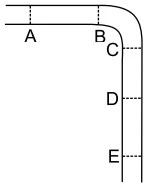
The last paragraph leads the reader to conclude that a) if - FGV 2016
Inglês - 2016Read the text and answer the question
China has created a monster it can’t control
By Jeremy Warner
3 Sep 2015
When in trouble, shoot the messenger. This timehonoured approach to dealing with unwelcome news was much in evidence in China this week when nearly 200 people were rounded up and criminally charged with spreading “false” rumours about the stock market and the economy, or otherwise profiting from their travails.
One luckless financial journalist was ritually paraded on state TV, tearfully confessing his “crimes”. Meanwhile, the head of the Chinese desk of one London-based hedge fund group was summoned to a “meeting” with regulators, and hasn’t been heard of since. Her Chinese husband says “she’s gone on holiday”. We can only hope it is not to the re-indoctrination of the asbestos mines. Despite the massive progress of recent decades, old habits die hard.
China was meant to have embraced free market reform, yet these latest actions suggest an altogether different approach. Roughly summarised, it amounts to: “Reform good, but woe betide the free market if it doesn’t do what the high command wants it to.” When the stock market was going up, the Chinese authorities were perfectly happy to tolerate what, to virtually all Western observers, looked like a dangerously speculative bubble, vaingloriously believing it to be a fair reflection of the wondrous successes of the Chinese economy.
The first rule of stock market investment – that share prices can go down as well as up – seems to have been almost wholly forgotten in the scramble for instant riches. When, inevitably, the stock market crashed, the authorities threw the kitchen sink at the problem, but they failed to halt the carnage. This was an even ruder awakening – for it demonstrated to an already disillusioned public that policy-makers were no longer in control of events. Perhaps they hadn’t noticed, but there are today more Chinese with stock trading accounts – some 90 million – than there are members of the Communist Party – “just” 80 million. In any case, powerless before the storm, the authorities have instead turned to scapegoating.
Apparently more liberal, advanced economies, it ought to be said, are by no means averse to this kind of behaviour either. A few years back, Italian prosecutors charged nine employees of Standard & Poor’s and Fitch Rating with market abuse for daring to downgrade Italy’s credit rating, while it is still commonplace in France to blame Anglo-Saxon speculators and their cronies in the London press for any financial or economic setback.
Nor are Western governments and central bankers averse to a little market manipulation when it suits them. What is “quantitative easing” other than money printing to prop up asset prices, including stocks and shares? Chinese refusal to accept the judgments of “Mr Market”, it might be argued, is just a more extreme version of the same thing. Small wonder that European officials sometimes look longingly across at the state-directed capitalism practised in China, and pronounce it a model we might perhaps aspire to ourselves.
As recent events have demonstrated, we should not. China’s stock market crash is not the work of malicious financial journalists and short-selling hedge funds, but a signal of difficult time ahead and perhaps even of an economic roadcrash to come. After nearly 35 years of spectacular progress, the Chinese economy faces multiple challenges on many fronts which are not going to be solved by denying harsh realities and imprisoning journalists.
The progress of recent decades belies an industrial sector which in truth has become quite seriously uncompetitive by international standards. Many of China’s factories need completely retooling to keep up with developments in robotics and other forms of mechanisation. Yet if industry is to get less labour intensive, this only further steepens the challenge of employment creation.
It is reckoned that China needs to create some 20 million jobs a year just to keep pace with employment demand as the population shifts from land to town, eight million of them in high-end professions to cater for the country’s burgeoning output of graduates. China’s modernisation has created a monster which it is struggling to feed.
As the export-growth story waned, China compensated by unleashing a massive investment boom, which internal demand is now struggling to keep up with, rendering many of the country’s shiny new constructs uneconomic and overburdened with bad debts.
The Chinese leadership looks to growth in consumption and service industries to plug the gap, but these new sources of demand can’t do so without further free-market reform, which in turn requires further loosening of the shackles of political control. Without growth, the Communist Party loses its political legitimacy, yet the old growth model is broken, and to achieve a new one, the authorities must cede the very power and influence that sustains them. Rumour-mongering journalists and short-selling speculators can only be blamed for so long.
(http://www.telegraph.co.uk. Adapted)
According to the tenth paragraph, a) internal demand in - FGV 2016
Inglês - 2016Read the text and answer the question
China has created a monster it can’t control
By Jeremy Warner
3 Sep 2015
When in trouble, shoot the messenger. This timehonoured approach to dealing with unwelcome news was much in evidence in China this week when nearly 200 people were rounded up and criminally charged with spreading “false” rumours about the stock market and the economy, or otherwise profiting from their travails.
One luckless financial journalist was ritually paraded on state TV, tearfully confessing his “crimes”. Meanwhile, the head of the Chinese desk of one London-based hedge fund group was summoned to a “meeting” with regulators, and hasn’t been heard of since. Her Chinese husband says “she’s gone on holiday”. We can only hope it is not to the re-indoctrination of the asbestos mines. Despite the massive progress of recent decades, old habits die hard.
China was meant to have embraced free market reform, yet these latest actions suggest an altogether different approach. Roughly summarised, it amounts to: “Reform good, but woe betide the free market if it doesn’t do what the high command wants it to.” When the stock market was going up, the Chinese authorities were perfectly happy to tolerate what, to virtually all Western observers, looked like a dangerously speculative bubble, vaingloriously believing it to be a fair reflection of the wondrous successes of the Chinese economy.
The first rule of stock market investment – that share prices can go down as well as up – seems to have been almost wholly forgotten in the scramble for instant riches. When, inevitably, the stock market crashed, the authorities threw the kitchen sink at the problem, but they failed to halt the carnage. This was an even ruder awakening – for it demonstrated to an already disillusioned public that policy-makers were no longer in control of events. Perhaps they hadn’t noticed, but there are today more Chinese with stock trading accounts – some 90 million – than there are members of the Communist Party – “just” 80 million. In any case, powerless before the storm, the authorities have instead turned to scapegoating.
Apparently more liberal, advanced economies, it ought to be said, are by no means averse to this kind of behaviour either. A few years back, Italian prosecutors charged nine employees of Standard & Poor’s and Fitch Rating with market abuse for daring to downgrade Italy’s credit rating, while it is still commonplace in France to blame Anglo-Saxon speculators and their cronies in the London press for any financial or economic setback.
Nor are Western governments and central bankers averse to a little market manipulation when it suits them. What is “quantitative easing” other than money printing to prop up asset prices, including stocks and shares? Chinese refusal to accept the judgments of “Mr Market”, it might be argued, is just a more extreme version of the same thing. Small wonder that European officials sometimes look longingly across at the state-directed capitalism practised in China, and pronounce it a model we might perhaps aspire to ourselves.
As recent events have demonstrated, we should not. China’s stock market crash is not the work of malicious financial journalists and short-selling hedge funds, but a signal of difficult time ahead and perhaps even of an economic roadcrash to come. After nearly 35 years of spectacular progress, the Chinese economy faces multiple challenges on many fronts which are not going to be solved by denying harsh realities and imprisoning journalists.
The progress of recent decades belies an industrial sector which in truth has become quite seriously uncompetitive by international standards. Many of China’s factories need completely retooling to keep up with developments in robotics and other forms of mechanisation. Yet if industry is to get less labour intensive, this only further steepens the challenge of employment creation.
It is reckoned that China needs to create some 20 million jobs a year just to keep pace with employment demand as the population shifts from land to town, eight million of them in high-end professions to cater for the country’s burgeoning output of graduates. China’s modernisation has created a monster which it is struggling to feed.
As the export-growth story waned, China compensated by unleashing a massive investment boom, which internal demand is now struggling to keep up with, rendering many of the country’s shiny new constructs uneconomic and overburdened with bad debts.
The Chinese leadership looks to growth in consumption and service industries to plug the gap, but these new sources of demand can’t do so without further free-market reform, which in turn requires further loosening of the shackles of political control. Without growth, the Communist Party loses its political legitimacy, yet the old growth model is broken, and to achieve a new one, the authorities must cede the very power and influence that sustains them. Rumour-mongering journalists and short-selling speculators can only be blamed for so long.
(http://www.telegraph.co.uk. Adapted)
In relation to the job market, the eight and ninth - FGV 2016
Inglês - 2016Read the text and answer the question
China has created a monster it can’t control
By Jeremy Warner
3 Sep 2015
When in trouble, shoot the messenger. This timehonoured approach to dealing with unwelcome news was much in evidence in China this week when nearly 200 people were rounded up and criminally charged with spreading “false” rumours about the stock market and the economy, or otherwise profiting from their travails.
One luckless financial journalist was ritually paraded on state TV, tearfully confessing his “crimes”. Meanwhile, the head of the Chinese desk of one London-based hedge fund group was summoned to a “meeting” with regulators, and hasn’t been heard of since. Her Chinese husband says “she’s gone on holiday”. We can only hope it is not to the re-indoctrination of the asbestos mines. Despite the massive progress of recent decades, old habits die hard.
China was meant to have embraced free market reform, yet these latest actions suggest an altogether different approach. Roughly summarised, it amounts to: “Reform good, but woe betide the free market if it doesn’t do what the high command wants it to.” When the stock market was going up, the Chinese authorities were perfectly happy to tolerate what, to virtually all Western observers, looked like a dangerously speculative bubble, vaingloriously believing it to be a fair reflection of the wondrous successes of the Chinese economy.
The first rule of stock market investment – that share prices can go down as well as up – seems to have been almost wholly forgotten in the scramble for instant riches. When, inevitably, the stock market crashed, the authorities threw the kitchen sink at the problem, but they failed to halt the carnage. This was an even ruder awakening – for it demonstrated to an already disillusioned public that policy-makers were no longer in control of events. Perhaps they hadn’t noticed, but there are today more Chinese with stock trading accounts – some 90 million – than there are members of the Communist Party – “just” 80 million. In any case, powerless before the storm, the authorities have instead turned to scapegoating.
Apparently more liberal, advanced economies, it ought to be said, are by no means averse to this kind of behaviour either. A few years back, Italian prosecutors charged nine employees of Standard & Poor’s and Fitch Rating with market abuse for daring to downgrade Italy’s credit rating, while it is still commonplace in France to blame Anglo-Saxon speculators and their cronies in the London press for any financial or economic setback.
Nor are Western governments and central bankers averse to a little market manipulation when it suits them. What is “quantitative easing” other than money printing to prop up asset prices, including stocks and shares? Chinese refusal to accept the judgments of “Mr Market”, it might be argued, is just a more extreme version of the same thing. Small wonder that European officials sometimes look longingly across at the state-directed capitalism practised in China, and pronounce it a model we might perhaps aspire to ourselves.
As recent events have demonstrated, we should not. China’s stock market crash is not the work of malicious financial journalists and short-selling hedge funds, but a signal of difficult time ahead and perhaps even of an economic roadcrash to come. After nearly 35 years of spectacular progress, the Chinese economy faces multiple challenges on many fronts which are not going to be solved by denying harsh realities and imprisoning journalists.
The progress of recent decades belies an industrial sector which in truth has become quite seriously uncompetitive by international standards. Many of China’s factories need completely retooling to keep up with developments in robotics and other forms of mechanisation. Yet if industry is to get less labour intensive, this only further steepens the challenge of employment creation.
It is reckoned that China needs to create some 20 million jobs a year just to keep pace with employment demand as the population shifts from land to town, eight million of them in high-end professions to cater for the country’s burgeoning output of graduates. China’s modernisation has created a monster which it is struggling to feed.
As the export-growth story waned, China compensated by unleashing a massive investment boom, which internal demand is now struggling to keep up with, rendering many of the country’s shiny new constructs uneconomic and overburdened with bad debts.
The Chinese leadership looks to growth in consumption and service industries to plug the gap, but these new sources of demand can’t do so without further free-market reform, which in turn requires further loosening of the shackles of political control. Without growth, the Communist Party loses its political legitimacy, yet the old growth model is broken, and to achieve a new one, the authorities must cede the very power and influence that sustains them. Rumour-mongering journalists and short-selling speculators can only be blamed for so long.
(http://www.telegraph.co.uk. Adapted)
The seventh paragraph begins with the statement – As recen - FGV 2016
Inglês - 2016Read the text and answer the question
China has created a monster it can’t control
By Jeremy Warner
3 Sep 2015
When in trouble, shoot the messenger. This timehonoured approach to dealing with unwelcome news was much in evidence in China this week when nearly 200 people were rounded up and criminally charged with spreading “false” rumours about the stock market and the economy, or otherwise profiting from their travails.
One luckless financial journalist was ritually paraded on state TV, tearfully confessing his “crimes”. Meanwhile, the head of the Chinese desk of one London-based hedge fund group was summoned to a “meeting” with regulators, and hasn’t been heard of since. Her Chinese husband says “she’s gone on holiday”. We can only hope it is not to the re-indoctrination of the asbestos mines. Despite the massive progress of recent decades, old habits die hard.
China was meant to have embraced free market reform, yet these latest actions suggest an altogether different approach. Roughly summarised, it amounts to: “Reform good, but woe betide the free market if it doesn’t do what the high command wants it to.” When the stock market was going up, the Chinese authorities were perfectly happy to tolerate what, to virtually all Western observers, looked like a dangerously speculative bubble, vaingloriously believing it to be a fair reflection of the wondrous successes of the Chinese economy.
The first rule of stock market investment – that share prices can go down as well as up – seems to have been almost wholly forgotten in the scramble for instant riches. When, inevitably, the stock market crashed, the authorities threw the kitchen sink at the problem, but they failed to halt the carnage. This was an even ruder awakening – for it demonstrated to an already disillusioned public that policy-makers were no longer in control of events. Perhaps they hadn’t noticed, but there are today more Chinese with stock trading accounts – some 90 million – than there are members of the Communist Party – “just” 80 million. In any case, powerless before the storm, the authorities have instead turned to scapegoating.
Apparently more liberal, advanced economies, it ought to be said, are by no means averse to this kind of behaviour either. A few years back, Italian prosecutors charged nine employees of Standard & Poor’s and Fitch Rating with market abuse for daring to downgrade Italy’s credit rating, while it is still commonplace in France to blame Anglo-Saxon speculators and their cronies in the London press for any financial or economic setback.
Nor are Western governments and central bankers averse to a little market manipulation when it suits them. What is “quantitative easing” other than money printing to prop up asset prices, including stocks and shares? Chinese refusal to accept the judgments of “Mr Market”, it might be argued, is just a more extreme version of the same thing. Small wonder that European officials sometimes look longingly across at the state-directed capitalism practised in China, and pronounce it a model we might perhaps aspire to ourselves.
As recent events have demonstrated, we should not. China’s stock market crash is not the work of malicious financial journalists and short-selling hedge funds, but a signal of difficult time ahead and perhaps even of an economic roadcrash to come. After nearly 35 years of spectacular progress, the Chinese economy faces multiple challenges on many fronts which are not going to be solved by denying harsh realities and imprisoning journalists.
The progress of recent decades belies an industrial sector which in truth has become quite seriously uncompetitive by international standards. Many of China’s factories need completely retooling to keep up with developments in robotics and other forms of mechanisation. Yet if industry is to get less labour intensive, this only further steepens the challenge of employment creation.
It is reckoned that China needs to create some 20 million jobs a year just to keep pace with employment demand as the population shifts from land to town, eight million of them in high-end professions to cater for the country’s burgeoning output of graduates. China’s modernisation has created a monster which it is struggling to feed.
As the export-growth story waned, China compensated by unleashing a massive investment boom, which internal demand is now struggling to keep up with, rendering many of the country’s shiny new constructs uneconomic and overburdened with bad debts.
The Chinese leadership looks to growth in consumption and service industries to plug the gap, but these new sources of demand can’t do so without further free-market reform, which in turn requires further loosening of the shackles of political control. Without growth, the Communist Party loses its political legitimacy, yet the old growth model is broken, and to achieve a new one, the authorities must cede the very power and influence that sustains them. Rumour-mongering journalists and short-selling speculators can only be blamed for so long.
(http://www.telegraph.co.uk. Adapted)
In the excerpt from the sixth paragraph – European official - FGV 2016
Inglês - 2016Read the text and answer the question
China has created a monster it can’t control
By Jeremy Warner
3 Sep 2015
When in trouble, shoot the messenger. This timehonoured approach to dealing with unwelcome news was much in evidence in China this week when nearly 200 people were rounded up and criminally charged with spreading “false” rumours about the stock market and the economy, or otherwise profiting from their travails.
One luckless financial journalist was ritually paraded on state TV, tearfully confessing his “crimes”. Meanwhile, the head of the Chinese desk of one London-based hedge fund group was summoned to a “meeting” with regulators, and hasn’t been heard of since. Her Chinese husband says “she’s gone on holiday”. We can only hope it is not to the re-indoctrination of the asbestos mines. Despite the massive progress of recent decades, old habits die hard.
China was meant to have embraced free market reform, yet these latest actions suggest an altogether different approach. Roughly summarised, it amounts to: “Reform good, but woe betide the free market if it doesn’t do what the high command wants it to.” When the stock market was going up, the Chinese authorities were perfectly happy to tolerate what, to virtually all Western observers, looked like a dangerously speculative bubble, vaingloriously believing it to be a fair reflection of the wondrous successes of the Chinese economy.
The first rule of stock market investment – that share prices can go down as well as up – seems to have been almost wholly forgotten in the scramble for instant riches. When, inevitably, the stock market crashed, the authorities threw the kitchen sink at the problem, but they failed to halt the carnage. This was an even ruder awakening – for it demonstrated to an already disillusioned public that policy-makers were no longer in control of events. Perhaps they hadn’t noticed, but there are today more Chinese with stock trading accounts – some 90 million – than there are members of the Communist Party – “just” 80 million. In any case, powerless before the storm, the authorities have instead turned to scapegoating.
Apparently more liberal, advanced economies, it ought to be said, are by no means averse to this kind of behaviour either. A few years back, Italian prosecutors charged nine employees of Standard & Poor’s and Fitch Rating with market abuse for daring to downgrade Italy’s credit rating, while it is still commonplace in France to blame Anglo-Saxon speculators and their cronies in the London press for any financial or economic setback.
Nor are Western governments and central bankers averse to a little market manipulation when it suits them. What is “quantitative easing” other than money printing to prop up asset prices, including stocks and shares? Chinese refusal to accept the judgments of “Mr Market”, it might be argued, is just a more extreme version of the same thing. Small wonder that European officials sometimes look longingly across at the state-directed capitalism practised in China, and pronounce it a model we might perhaps aspire to ourselves.
As recent events have demonstrated, we should not. China’s stock market crash is not the work of malicious financial journalists and short-selling hedge funds, but a signal of difficult time ahead and perhaps even of an economic roadcrash to come. After nearly 35 years of spectacular progress, the Chinese economy faces multiple challenges on many fronts which are not going to be solved by denying harsh realities and imprisoning journalists.
The progress of recent decades belies an industrial sector which in truth has become quite seriously uncompetitive by international standards. Many of China’s factories need completely retooling to keep up with developments in robotics and other forms of mechanisation. Yet if industry is to get less labour intensive, this only further steepens the challenge of employment creation.
It is reckoned that China needs to create some 20 million jobs a year just to keep pace with employment demand as the population shifts from land to town, eight million of them in high-end professions to cater for the country’s burgeoning output of graduates. China’s modernisation has created a monster which it is struggling to feed.
As the export-growth story waned, China compensated by unleashing a massive investment boom, which internal demand is now struggling to keep up with, rendering many of the country’s shiny new constructs uneconomic and overburdened with bad debts.
The Chinese leadership looks to growth in consumption and service industries to plug the gap, but these new sources of demand can’t do so without further free-market reform, which in turn requires further loosening of the shackles of political control. Without growth, the Communist Party loses its political legitimacy, yet the old growth model is broken, and to achieve a new one, the authorities must cede the very power and influence that sustains them. Rumour-mongering journalists and short-selling speculators can only be blamed for so long.
(http://www.telegraph.co.uk. Adapted)
The fifth and sixth paragraphs together show that (A) - FGV 2016
Inglês - 2016Read the text and answer the question
China has created a monster it can’t control
By Jeremy Warner
3 Sep 2015
When in trouble, shoot the messenger. This timehonoured approach to dealing with unwelcome news was much in evidence in China this week when nearly 200 people were rounded up and criminally charged with spreading “false” rumours about the stock market and the economy, or otherwise profiting from their travails.
One luckless financial journalist was ritually paraded on state TV, tearfully confessing his “crimes”. Meanwhile, the head of the Chinese desk of one London-based hedge fund group was summoned to a “meeting” with regulators, and hasn’t been heard of since. Her Chinese husband says “she’s gone on holiday”. We can only hope it is not to the re-indoctrination of the asbestos mines. Despite the massive progress of recent decades, old habits die hard.
China was meant to have embraced free market reform, yet these latest actions suggest an altogether different approach. Roughly summarised, it amounts to: “Reform good, but woe betide the free market if it doesn’t do what the high command wants it to.” When the stock market was going up, the Chinese authorities were perfectly happy to tolerate what, to virtually all Western observers, looked like a dangerously speculative bubble, vaingloriously believing it to be a fair reflection of the wondrous successes of the Chinese economy.
The first rule of stock market investment – that share prices can go down as well as up – seems to have been almost wholly forgotten in the scramble for instant riches. When, inevitably, the stock market crashed, the authorities threw the kitchen sink at the problem, but they failed to halt the carnage. This was an even ruder awakening – for it demonstrated to an already disillusioned public that policy-makers were no longer in control of events. Perhaps they hadn’t noticed, but there are today more Chinese with stock trading accounts – some 90 million – than there are members of the Communist Party – “just” 80 million. In any case, powerless before the storm, the authorities have instead turned to scapegoating.
Apparently more liberal, advanced economies, it ought to be said, are by no means averse to this kind of behaviour either. A few years back, Italian prosecutors charged nine employees of Standard & Poor’s and Fitch Rating with market abuse for daring to downgrade Italy’s credit rating, while it is still commonplace in France to blame Anglo-Saxon speculators and their cronies in the London press for any financial or economic setback.
Nor are Western governments and central bankers averse to a little market manipulation when it suits them. What is “quantitative easing” other than money printing to prop up asset prices, including stocks and shares? Chinese refusal to accept the judgments of “Mr Market”, it might be argued, is just a more extreme version of the same thing. Small wonder that European officials sometimes look longingly across at the state-directed capitalism practised in China, and pronounce it a model we might perhaps aspire to ourselves.
As recent events have demonstrated, we should not. China’s stock market crash is not the work of malicious financial journalists and short-selling hedge funds, but a signal of difficult time ahead and perhaps even of an economic roadcrash to come. After nearly 35 years of spectacular progress, the Chinese economy faces multiple challenges on many fronts which are not going to be solved by denying harsh realities and imprisoning journalists.
The progress of recent decades belies an industrial sector which in truth has become quite seriously uncompetitive by international standards. Many of China’s factories need completely retooling to keep up with developments in robotics and other forms of mechanisation. Yet if industry is to get less labour intensive, this only further steepens the challenge of employment creation.
It is reckoned that China needs to create some 20 million jobs a year just to keep pace with employment demand as the population shifts from land to town, eight million of them in high-end professions to cater for the country’s burgeoning output of graduates. China’s modernisation has created a monster which it is struggling to feed.
As the export-growth story waned, China compensated by unleashing a massive investment boom, which internal demand is now struggling to keep up with, rendering many of the country’s shiny new constructs uneconomic and overburdened with bad debts.
The Chinese leadership looks to growth in consumption and service industries to plug the gap, but these new sources of demand can’t do so without further free-market reform, which in turn requires further loosening of the shackles of political control. Without growth, the Communist Party loses its political legitimacy, yet the old growth model is broken, and to achieve a new one, the authorities must cede the very power and influence that sustains them. Rumour-mongering journalists and short-selling speculators can only be blamed for so long.
(http://www.telegraph.co.uk. Adapted)
In the last sentence of the fourth paragraph, the excerpt - FGV 2016
Inglês - 2016Read the text and answer the question
China has created a monster it can’t control
By Jeremy Warner
3 Sep 2015
When in trouble, shoot the messenger. This timehonoured approach to dealing with unwelcome news was much in evidence in China this week when nearly 200 people were rounded up and criminally charged with spreading “false” rumours about the stock market and the economy, or otherwise profiting from their travails.
One luckless financial journalist was ritually paraded on state TV, tearfully confessing his “crimes”. Meanwhile, the head of the Chinese desk of one London-based hedge fund group was summoned to a “meeting” with regulators, and hasn’t been heard of since. Her Chinese husband says “she’s gone on holiday”. We can only hope it is not to the re-indoctrination of the asbestos mines. Despite the massive progress of recent decades, old habits die hard.
China was meant to have embraced free market reform, yet these latest actions suggest an altogether different approach. Roughly summarised, it amounts to: “Reform good, but woe betide the free market if it doesn’t do what the high command wants it to.” When the stock market was going up, the Chinese authorities were perfectly happy to tolerate what, to virtually all Western observers, looked like a dangerously speculative bubble, vaingloriously believing it to be a fair reflection of the wondrous successes of the Chinese economy.
The first rule of stock market investment – that share prices can go down as well as up – seems to have been almost wholly forgotten in the scramble for instant riches. When, inevitably, the stock market crashed, the authorities threw the kitchen sink at the problem, but they failed to halt the carnage. This was an even ruder awakening – for it demonstrated to an already disillusioned public that policy-makers were no longer in control of events. Perhaps they hadn’t noticed, but there are today more Chinese with stock trading accounts – some 90 million – than there are members of the Communist Party – “just” 80 million. In any case, powerless before the storm, the authorities have instead turned to scapegoating.
Apparently more liberal, advanced economies, it ought to be said, are by no means averse to this kind of behaviour either. A few years back, Italian prosecutors charged nine employees of Standard & Poor’s and Fitch Rating with market abuse for daring to downgrade Italy’s credit rating, while it is still commonplace in France to blame Anglo-Saxon speculators and their cronies in the London press for any financial or economic setback.
Nor are Western governments and central bankers averse to a little market manipulation when it suits them. What is “quantitative easing” other than money printing to prop up asset prices, including stocks and shares? Chinese refusal to accept the judgments of “Mr Market”, it might be argued, is just a more extreme version of the same thing. Small wonder that European officials sometimes look longingly across at the state-directed capitalism practised in China, and pronounce it a model we might perhaps aspire to ourselves.
As recent events have demonstrated, we should not. China’s stock market crash is not the work of malicious financial journalists and short-selling hedge funds, but a signal of difficult time ahead and perhaps even of an economic roadcrash to come. After nearly 35 years of spectacular progress, the Chinese economy faces multiple challenges on many fronts which are not going to be solved by denying harsh realities and imprisoning journalists.
The progress of recent decades belies an industrial sector which in truth has become quite seriously uncompetitive by international standards. Many of China’s factories need completely retooling to keep up with developments in robotics and other forms of mechanisation. Yet if industry is to get less labour intensive, this only further steepens the challenge of employment creation.
It is reckoned that China needs to create some 20 million jobs a year just to keep pace with employment demand as the population shifts from land to town, eight million of them in high-end professions to cater for the country’s burgeoning output of graduates. China’s modernisation has created a monster which it is struggling to feed.
As the export-growth story waned, China compensated by unleashing a massive investment boom, which internal demand is now struggling to keep up with, rendering many of the country’s shiny new constructs uneconomic and overburdened with bad debts.
The Chinese leadership looks to growth in consumption and service industries to plug the gap, but these new sources of demand can’t do so without further free-market reform, which in turn requires further loosening of the shackles of political control. Without growth, the Communist Party loses its political legitimacy, yet the old growth model is broken, and to achieve a new one, the authorities must cede the very power and influence that sustains them. Rumour-mongering journalists and short-selling speculators can only be blamed for so long.
(http://www.telegraph.co.uk. Adapted)
The fourth paragraph shows that the Chinese administration - FGV 2016
Inglês - 2016Read the text and answer the question
China has created a monster it can’t control
By Jeremy Warner
3 Sep 2015
When in trouble, shoot the messenger. This timehonoured approach to dealing with unwelcome news was much in evidence in China this week when nearly 200 people were rounded up and criminally charged with spreading “false” rumours about the stock market and the economy, or otherwise profiting from their travails.
One luckless financial journalist was ritually paraded on state TV, tearfully confessing his “crimes”. Meanwhile, the head of the Chinese desk of one London-based hedge fund group was summoned to a “meeting” with regulators, and hasn’t been heard of since. Her Chinese husband says “she’s gone on holiday”. We can only hope it is not to the re-indoctrination of the asbestos mines. Despite the massive progress of recent decades, old habits die hard.
China was meant to have embraced free market reform, yet these latest actions suggest an altogether different approach. Roughly summarised, it amounts to: “Reform good, but woe betide the free market if it doesn’t do what the high command wants it to.” When the stock market was going up, the Chinese authorities were perfectly happy to tolerate what, to virtually all Western observers, looked like a dangerously speculative bubble, vaingloriously believing it to be a fair reflection of the wondrous successes of the Chinese economy.
The first rule of stock market investment – that share prices can go down as well as up – seems to have been almost wholly forgotten in the scramble for instant riches. When, inevitably, the stock market crashed, the authorities threw the kitchen sink at the problem, but they failed to halt the carnage. This was an even ruder awakening – for it demonstrated to an already disillusioned public that policy-makers were no longer in control of events. Perhaps they hadn’t noticed, but there are today more Chinese with stock trading accounts – some 90 million – than there are members of the Communist Party – “just” 80 million. In any case, powerless before the storm, the authorities have instead turned to scapegoating.
Apparently more liberal, advanced economies, it ought to be said, are by no means averse to this kind of behaviour either. A few years back, Italian prosecutors charged nine employees of Standard & Poor’s and Fitch Rating with market abuse for daring to downgrade Italy’s credit rating, while it is still commonplace in France to blame Anglo-Saxon speculators and their cronies in the London press for any financial or economic setback.
Nor are Western governments and central bankers averse to a little market manipulation when it suits them. What is “quantitative easing” other than money printing to prop up asset prices, including stocks and shares? Chinese refusal to accept the judgments of “Mr Market”, it might be argued, is just a more extreme version of the same thing. Small wonder that European officials sometimes look longingly across at the state-directed capitalism practised in China, and pronounce it a model we might perhaps aspire to ourselves.
As recent events have demonstrated, we should not. China’s stock market crash is not the work of malicious financial journalists and short-selling hedge funds, but a signal of difficult time ahead and perhaps even of an economic roadcrash to come. After nearly 35 years of spectacular progress, the Chinese economy faces multiple challenges on many fronts which are not going to be solved by denying harsh realities and imprisoning journalists.
The progress of recent decades belies an industrial sector which in truth has become quite seriously uncompetitive by international standards. Many of China’s factories need completely retooling to keep up with developments in robotics and other forms of mechanisation. Yet if industry is to get less labour intensive, this only further steepens the challenge of employment creation.
It is reckoned that China needs to create some 20 million jobs a year just to keep pace with employment demand as the population shifts from land to town, eight million of them in high-end professions to cater for the country’s burgeoning output of graduates. China’s modernisation has created a monster which it is struggling to feed.
As the export-growth story waned, China compensated by unleashing a massive investment boom, which internal demand is now struggling to keep up with, rendering many of the country’s shiny new constructs uneconomic and overburdened with bad debts.
The Chinese leadership looks to growth in consumption and service industries to plug the gap, but these new sources of demand can’t do so without further free-market reform, which in turn requires further loosening of the shackles of political control. Without growth, the Communist Party loses its political legitimacy, yet the old growth model is broken, and to achieve a new one, the authorities must cede the very power and influence that sustains them. Rumour-mongering journalists and short-selling speculators can only be blamed for so long.
(http://www.telegraph.co.uk. Adapted)
The third paragraph points out to the fact that the Chinese - FGV 2016
Inglês - 2016Read the text and answer the question
China has created a monster it can’t control
By Jeremy Warner
3 Sep 2015
When in trouble, shoot the messenger. This timehonoured approach to dealing with unwelcome news was much in evidence in China this week when nearly 200 people were rounded up and criminally charged with spreading “false” rumours about the stock market and the economy, or otherwise profiting from their travails.
One luckless financial journalist was ritually paraded on state TV, tearfully confessing his “crimes”. Meanwhile, the head of the Chinese desk of one London-based hedge fund group was summoned to a “meeting” with regulators, and hasn’t been heard of since. Her Chinese husband says “she’s gone on holiday”. We can only hope it is not to the re-indoctrination of the asbestos mines. Despite the massive progress of recent decades, old habits die hard.
China was meant to have embraced free market reform, yet these latest actions suggest an altogether different approach. Roughly summarised, it amounts to: “Reform good, but woe betide the free market if it doesn’t do what the high command wants it to.” When the stock market was going up, the Chinese authorities were perfectly happy to tolerate what, to virtually all Western observers, looked like a dangerously speculative bubble, vaingloriously believing it to be a fair reflection of the wondrous successes of the Chinese economy.
The first rule of stock market investment – that share prices can go down as well as up – seems to have been almost wholly forgotten in the scramble for instant riches. When, inevitably, the stock market crashed, the authorities threw the kitchen sink at the problem, but they failed to halt the carnage. This was an even ruder awakening – for it demonstrated to an already disillusioned public that policy-makers were no longer in control of events. Perhaps they hadn’t noticed, but there are today more Chinese with stock trading accounts – some 90 million – than there are members of the Communist Party – “just” 80 million. In any case, powerless before the storm, the authorities have instead turned to scapegoating.
Apparently more liberal, advanced economies, it ought to be said, are by no means averse to this kind of behaviour either. A few years back, Italian prosecutors charged nine employees of Standard & Poor’s and Fitch Rating with market abuse for daring to downgrade Italy’s credit rating, while it is still commonplace in France to blame Anglo-Saxon speculators and their cronies in the London press for any financial or economic setback.
Nor are Western governments and central bankers averse to a little market manipulation when it suits them. What is “quantitative easing” other than money printing to prop up asset prices, including stocks and shares? Chinese refusal to accept the judgments of “Mr Market”, it might be argued, is just a more extreme version of the same thing. Small wonder that European officials sometimes look longingly across at the state-directed capitalism practised in China, and pronounce it a model we might perhaps aspire to ourselves.
As recent events have demonstrated, we should not. China’s stock market crash is not the work of malicious financial journalists and short-selling hedge funds, but a signal of difficult time ahead and perhaps even of an economic roadcrash to come. After nearly 35 years of spectacular progress, the Chinese economy faces multiple challenges on many fronts which are not going to be solved by denying harsh realities and imprisoning journalists.
The progress of recent decades belies an industrial sector which in truth has become quite seriously uncompetitive by international standards. Many of China’s factories need completely retooling to keep up with developments in robotics and other forms of mechanisation. Yet if industry is to get less labour intensive, this only further steepens the challenge of employment creation.
It is reckoned that China needs to create some 20 million jobs a year just to keep pace with employment demand as the population shifts from land to town, eight million of them in high-end professions to cater for the country’s burgeoning output of graduates. China’s modernisation has created a monster which it is struggling to feed.
As the export-growth story waned, China compensated by unleashing a massive investment boom, which internal demand is now struggling to keep up with, rendering many of the country’s shiny new constructs uneconomic and overburdened with bad debts.
The Chinese leadership looks to growth in consumption and service industries to plug the gap, but these new sources of demand can’t do so without further free-market reform, which in turn requires further loosening of the shackles of political control. Without growth, the Communist Party loses its political legitimacy, yet the old growth model is broken, and to achieve a new one, the authorities must cede the very power and influence that sustains them. Rumour-mongering journalists and short-selling speculators can only be blamed for so long.
(http://www.telegraph.co.uk. Adapted)
The information contained in the first two paragraphs impli - FGV 2016
Inglês - 2016Read the text and answer the question
China has created a monster it can’t control
By Jeremy Warner
3 Sep 2015
When in trouble, shoot the messenger. This timehonoured approach to dealing with unwelcome news was much in evidence in China this week when nearly 200 people were rounded up and criminally charged with spreading “false” rumours about the stock market and the economy, or otherwise profiting from their travails.
One luckless financial journalist was ritually paraded on state TV, tearfully confessing his “crimes”. Meanwhile, the head of the Chinese desk of one London-based hedge fund group was summoned to a “meeting” with regulators, and hasn’t been heard of since. Her Chinese husband says “she’s gone on holiday”. We can only hope it is not to the re-indoctrination of the asbestos mines. Despite the massive progress of recent decades, old habits die hard.
China was meant to have embraced free market reform, yet these latest actions suggest an altogether different approach. Roughly summarised, it amounts to: “Reform good, but woe betide the free market if it doesn’t do what the high command wants it to.” When the stock market was going up, the Chinese authorities were perfectly happy to tolerate what, to virtually all Western observers, looked like a dangerously speculative bubble, vaingloriously believing it to be a fair reflection of the wondrous successes of the Chinese economy.
The first rule of stock market investment – that share prices can go down as well as up – seems to have been almost wholly forgotten in the scramble for instant riches. When, inevitably, the stock market crashed, the authorities threw the kitchen sink at the problem, but they failed to halt the carnage. This was an even ruder awakening – for it demonstrated to an already disillusioned public that policy-makers were no longer in control of events. Perhaps they hadn’t noticed, but there are today more Chinese with stock trading accounts – some 90 million – than there are members of the Communist Party – “just” 80 million. In any case, powerless before the storm, the authorities have instead turned to scapegoating.
Apparently more liberal, advanced economies, it ought to be said, are by no means averse to this kind of behaviour either. A few years back, Italian prosecutors charged nine employees of Standard & Poor’s and Fitch Rating with market abuse for daring to downgrade Italy’s credit rating, while it is still commonplace in France to blame Anglo-Saxon speculators and their cronies in the London press for any financial or economic setback.
Nor are Western governments and central bankers averse to a little market manipulation when it suits them. What is “quantitative easing” other than money printing to prop up asset prices, including stocks and shares? Chinese refusal to accept the judgments of “Mr Market”, it might be argued, is just a more extreme version of the same thing. Small wonder that European officials sometimes look longingly across at the state-directed capitalism practised in China, and pronounce it a model we might perhaps aspire to ourselves.
As recent events have demonstrated, we should not. China’s stock market crash is not the work of malicious financial journalists and short-selling hedge funds, but a signal of difficult time ahead and perhaps even of an economic roadcrash to come. After nearly 35 years of spectacular progress, the Chinese economy faces multiple challenges on many fronts which are not going to be solved by denying harsh realities and imprisoning journalists.
The progress of recent decades belies an industrial sector which in truth has become quite seriously uncompetitive by international standards. Many of China’s factories need completely retooling to keep up with developments in robotics and other forms of mechanisation. Yet if industry is to get less labour intensive, this only further steepens the challenge of employment creation.
It is reckoned that China needs to create some 20 million jobs a year just to keep pace with employment demand as the population shifts from land to town, eight million of them in high-end professions to cater for the country’s burgeoning output of graduates. China’s modernisation has created a monster which it is struggling to feed.
As the export-growth story waned, China compensated by unleashing a massive investment boom, which internal demand is now struggling to keep up with, rendering many of the country’s shiny new constructs uneconomic and overburdened with bad debts.
The Chinese leadership looks to growth in consumption and service industries to plug the gap, but these new sources of demand can’t do so without further free-market reform, which in turn requires further loosening of the shackles of political control. Without growth, the Communist Party loses its political legitimacy, yet the old growth model is broken, and to achieve a new one, the authorities must cede the very power and influence that sustains them. Rumour-mongering journalists and short-selling speculators can only be blamed for so long.
(http://www.telegraph.co.uk. Adapted)
Two years before the article was written, sales in real - FGV 2016
Inglês - 2016Read the text and answer the question
A Housing Meltdown Looms in Brazil as Builders Seek Debt Relief
by Julia Leite and Paula Sambo
August 26, 2015
Not long ago, Brazil’s real-estate market was one of the biggest symbols of the country’s burgeoning economic might. Now, it’s fallen victim to an ever-deepening recession. PDG Realty SA, once the largest homebuilder by revenue, hired Rothschild last week to help restructure 5.8 billion reais ($1.6 billion) of debt after second-quarter net sales sank 88 percent. Earlier this month, Rossi Residencial SA, which has 2.5 billion reais in debt, also brought in advisers to “restructure operations and review strategies.” Since 2010, the builder has lost 99 percent of its stock-market value.
The real-estate industry, which is equal to about 10 percent of Brazil’s economy, is emerging as one of the latest casualties of a recession that analysts forecast will be its longest since the 1930s. To make matters worse, interest rates are the highest in almost a decade while inflation is soaring. “There is no real estate company that survives without sales,” Bruno Mendonça Lima de Carvalho, the head of fixed income at Guide Investimentos SA, said from Sao Paulo. “You can’t import or export apartments. You’re relying solely on domestic activity.”
PDG tried to boost revenue by lowering prices, financing up to 20 percent of some home purchases and even offering to buy back apartments if banks deny financing. Still, it sold just 217 units in the second quarter on a net basis, compared with 1,749 in 2014.
Negative Outlook
On Friday, Moody’s Investors Service cut PDG’s rating three levels to Caa3, citing the possibility of significant losses for bondholders and other lenders. Secured creditors may recover less than 80 percent in a default, according to Moody’s, which kept a negative outlook on the rating. “The company is facing additional liquidity pressures from a prolonged deterioration in industry dynamics, including weak sales speed, tight financing availability and declining real estate prices,” Moody’s said.
Sao Paulo-based Rossi said in an e-mailed response to questions that second quarter sales improved and that the company’s main focus is to reduce debt. Gross debt fell about 30 percent in the 12 months ended in June, Rossi said.
Home sales in Latin America’s biggest economy tumbled 14 percent in the first half of 2015, according to data from the national real estate institute. Builders cut new projects by 20 percent during that span, while available financing shrank by about a quarter
Real’s Collapse
That’s a reversal from just two years ago, when realestate prices in places like Rio de Janeiro and Sao Paulo had surged as much as 230 percent as rising incomes, a soaring real and record-low borrowing costs ignited a wave of home buying.
Brazilians find themselves in drastically different circumstances today. The currency fell 0.4 percent Wednesday as of 3:25 p.m. in New York, extending its loss this year to 26 percent. The jobless rate climbed to a five-year high of 7.5 percent last month.
The central bank boosted its key rate to 14.25 percent in July, making it ever more expensive to finance the purchase of a home. “It’s a matter of demand, and demand is really weak,” Will Landers, who manages Latin American stocks at BlackRock, said from Princeton, New Jersey. “We may have reached a peak in interest rates, but they should continue to be at these levels for a while. Consumers will stay on the sidelines because debt levels are still high, and employment will get worse.”
(Business Week at www.bloomberg.com/news. Adapted)
Rossi, one of the real-estate businesses mentioned in the a - FGV 2016
Inglês - 2016Read the text and answer the question
A Housing Meltdown Looms in Brazil as Builders Seek Debt Relief
by Julia Leite and Paula Sambo
August 26, 2015
Not long ago, Brazil’s real-estate market was one of the biggest symbols of the country’s burgeoning economic might. Now, it’s fallen victim to an ever-deepening recession. PDG Realty SA, once the largest homebuilder by revenue, hired Rothschild last week to help restructure 5.8 billion reais ($1.6 billion) of debt after second-quarter net sales sank 88 percent. Earlier this month, Rossi Residencial SA, which has 2.5 billion reais in debt, also brought in advisers to “restructure operations and review strategies.” Since 2010, the builder has lost 99 percent of its stock-market value.
The real-estate industry, which is equal to about 10 percent of Brazil’s economy, is emerging as one of the latest casualties of a recession that analysts forecast will be its longest since the 1930s. To make matters worse, interest rates are the highest in almost a decade while inflation is soaring. “There is no real estate company that survives without sales,” Bruno Mendonça Lima de Carvalho, the head of fixed income at Guide Investimentos SA, said from Sao Paulo. “You can’t import or export apartments. You’re relying solely on domestic activity.”
PDG tried to boost revenue by lowering prices, financing up to 20 percent of some home purchases and even offering to buy back apartments if banks deny financing. Still, it sold just 217 units in the second quarter on a net basis, compared with 1,749 in 2014.
Negative Outlook
On Friday, Moody’s Investors Service cut PDG’s rating three levels to Caa3, citing the possibility of significant losses for bondholders and other lenders. Secured creditors may recover less than 80 percent in a default, according to Moody’s, which kept a negative outlook on the rating. “The company is facing additional liquidity pressures from a prolonged deterioration in industry dynamics, including weak sales speed, tight financing availability and declining real estate prices,” Moody’s said.
Sao Paulo-based Rossi said in an e-mailed response to questions that second quarter sales improved and that the company’s main focus is to reduce debt. Gross debt fell about 30 percent in the 12 months ended in June, Rossi said.
Home sales in Latin America’s biggest economy tumbled 14 percent in the first half of 2015, according to data from the national real estate institute. Builders cut new projects by 20 percent during that span, while available financing shrank by about a quarter
Real’s Collapse
That’s a reversal from just two years ago, when realestate prices in places like Rio de Janeiro and Sao Paulo had surged as much as 230 percent as rising incomes, a soaring real and record-low borrowing costs ignited a wave of home buying.
Brazilians find themselves in drastically different circumstances today. The currency fell 0.4 percent Wednesday as of 3:25 p.m. in New York, extending its loss this year to 26 percent. The jobless rate climbed to a five-year high of 7.5 percent last month.
The central bank boosted its key rate to 14.25 percent in July, making it ever more expensive to finance the purchase of a home. “It’s a matter of demand, and demand is really weak,” Will Landers, who manages Latin American stocks at BlackRock, said from Princeton, New Jersey. “We may have reached a peak in interest rates, but they should continue to be at these levels for a while. Consumers will stay on the sidelines because debt levels are still high, and employment will get worse.”
(Business Week at www.bloomberg.com/news. Adapted)
The evaluation of the real-estate company by Moody’s, as - FGV 2016
Geografia - 2016Read the text and answer the question
A Housing Meltdown Looms in Brazil as Builders Seek Debt Relief
by Julia Leite and Paula Sambo
August 26, 2015
Not long ago, Brazil’s real-estate market was one of the biggest symbols of the country’s burgeoning economic might. Now, it’s fallen victim to an ever-deepening recession. PDG Realty SA, once the largest homebuilder by revenue, hired Rothschild last week to help restructure 5.8 billion reais ($1.6 billion) of debt after second-quarter net sales sank 88 percent. Earlier this month, Rossi Residencial SA, which has 2.5 billion reais in debt, also brought in advisers to “restructure operations and review strategies.” Since 2010, the builder has lost 99 percent of its stock-market value.
The real-estate industry, which is equal to about 10 percent of Brazil’s economy, is emerging as one of the latest casualties of a recession that analysts forecast will be its longest since the 1930s. To make matters worse, interest rates are the highest in almost a decade while inflation is soaring. “There is no real estate company that survives without sales,” Bruno Mendonça Lima de Carvalho, the head of fixed income at Guide Investimentos SA, said from Sao Paulo. “You can’t import or export apartments. You’re relying solely on domestic activity.”
PDG tried to boost revenue by lowering prices, financing up to 20 percent of some home purchases and even offering to buy back apartments if banks deny financing. Still, it sold just 217 units in the second quarter on a net basis, compared with 1,749 in 2014.
Negative Outlook
On Friday, Moody’s Investors Service cut PDG’s rating three levels to Caa3, citing the possibility of significant losses for bondholders and other lenders. Secured creditors may recover less than 80 percent in a default, according to Moody’s, which kept a negative outlook on the rating. “The company is facing additional liquidity pressures from a prolonged deterioration in industry dynamics, including weak sales speed, tight financing availability and declining real estate prices,” Moody’s said.
Sao Paulo-based Rossi said in an e-mailed response to questions that second quarter sales improved and that the company’s main focus is to reduce debt. Gross debt fell about 30 percent in the 12 months ended in June, Rossi said.
Home sales in Latin America’s biggest economy tumbled 14 percent in the first half of 2015, according to data from the national real estate institute. Builders cut new projects by 20 percent during that span, while available financing shrank by about a quarter
Real’s Collapse
That’s a reversal from just two years ago, when realestate prices in places like Rio de Janeiro and Sao Paulo had surged as much as 230 percent as rising incomes, a soaring real and record-low borrowing costs ignited a wave of home buying.
Brazilians find themselves in drastically different circumstances today. The currency fell 0.4 percent Wednesday as of 3:25 p.m. in New York, extending its loss this year to 26 percent. The jobless rate climbed to a five-year high of 7.5 percent last month.
The central bank boosted its key rate to 14.25 percent in July, making it ever more expensive to finance the purchase of a home. “It’s a matter of demand, and demand is really weak,” Will Landers, who manages Latin American stocks at BlackRock, said from Princeton, New Jersey. “We may have reached a peak in interest rates, but they should continue to be at these levels for a while. Consumers will stay on the sidelines because debt levels are still high, and employment will get worse.”
(Business Week at www.bloomberg.com/news. Adapted)
The third paragraph implies that (A) with the high interest - FGV 2016
Inglês - 2016Read the text and answer the question
A Housing Meltdown Looms in Brazil as Builders Seek Debt Relief
by Julia Leite and Paula Sambo
August 26, 2015
Not long ago, Brazil’s real-estate market was one of the biggest symbols of the country’s burgeoning economic might. Now, it’s fallen victim to an ever-deepening recession. PDG Realty SA, once the largest homebuilder by revenue, hired Rothschild last week to help restructure 5.8 billion reais ($1.6 billion) of debt after second-quarter net sales sank 88 percent. Earlier this month, Rossi Residencial SA, which has 2.5 billion reais in debt, also brought in advisers to “restructure operations and review strategies.” Since 2010, the builder has lost 99 percent of its stock-market value.
The real-estate industry, which is equal to about 10 percent of Brazil’s economy, is emerging as one of the latest casualties of a recession that analysts forecast will be its longest since the 1930s. To make matters worse, interest rates are the highest in almost a decade while inflation is soaring. “There is no real estate company that survives without sales,” Bruno Mendonça Lima de Carvalho, the head of fixed income at Guide Investimentos SA, said from Sao Paulo. “You can’t import or export apartments. You’re relying solely on domestic activity.”
PDG tried to boost revenue by lowering prices, financing up to 20 percent of some home purchases and even offering to buy back apartments if banks deny financing. Still, it sold just 217 units in the second quarter on a net basis, compared with 1,749 in 2014.
Negative Outlook
On Friday, Moody’s Investors Service cut PDG’s rating three levels to Caa3, citing the possibility of significant losses for bondholders and other lenders. Secured creditors may recover less than 80 percent in a default, according to Moody’s, which kept a negative outlook on the rating. “The company is facing additional liquidity pressures from a prolonged deterioration in industry dynamics, including weak sales speed, tight financing availability and declining real estate prices,” Moody’s said.
Sao Paulo-based Rossi said in an e-mailed response to questions that second quarter sales improved and that the company’s main focus is to reduce debt. Gross debt fell about 30 percent in the 12 months ended in June, Rossi said.
Home sales in Latin America’s biggest economy tumbled 14 percent in the first half of 2015, according to data from the national real estate institute. Builders cut new projects by 20 percent during that span, while available financing shrank by about a quarter
Real’s Collapse
That’s a reversal from just two years ago, when realestate prices in places like Rio de Janeiro and Sao Paulo had surged as much as 230 percent as rising incomes, a soaring real and record-low borrowing costs ignited a wave of home buying.
Brazilians find themselves in drastically different circumstances today. The currency fell 0.4 percent Wednesday as of 3:25 p.m. in New York, extending its loss this year to 26 percent. The jobless rate climbed to a five-year high of 7.5 percent last month.
The central bank boosted its key rate to 14.25 percent in July, making it ever more expensive to finance the purchase of a home. “It’s a matter of demand, and demand is really weak,” Will Landers, who manages Latin American stocks at BlackRock, said from Princeton, New Jersey. “We may have reached a peak in interest rates, but they should continue to be at these levels for a while. Consumers will stay on the sidelines because debt levels are still high, and employment will get worse.”
(Business Week at www.bloomberg.com/news. Adapted)
According to the block comprising the first four paragraphs - FGV 2016
Inglês - 2016Read the text and answer the question
A Housing Meltdown Looms in Brazil as Builders Seek Debt Relief
by Julia Leite and Paula Sambo
August 26, 2015
Not long ago, Brazil’s real-estate market was one of the biggest symbols of the country’s burgeoning economic might. Now, it’s fallen victim to an ever-deepening recession. PDG Realty SA, once the largest homebuilder by revenue, hired Rothschild last week to help restructure 5.8 billion reais ($1.6 billion) of debt after second-quarter net sales sank 88 percent. Earlier this month, Rossi Residencial SA, which has 2.5 billion reais in debt, also brought in advisers to “restructure operations and review strategies.” Since 2010, the builder has lost 99 percent of its stock-market value.
The real-estate industry, which is equal to about 10 percent of Brazil’s economy, is emerging as one of the latest casualties of a recession that analysts forecast will be its longest since the 1930s. To make matters worse, interest rates are the highest in almost a decade while inflation is soaring. “There is no real estate company that survives without sales,” Bruno Mendonça Lima de Carvalho, the head of fixed income at Guide Investimentos SA, said from Sao Paulo. “You can’t import or export apartments. You’re relying solely on domestic activity.”
PDG tried to boost revenue by lowering prices, financing up to 20 percent of some home purchases and even offering to buy back apartments if banks deny financing. Still, it sold just 217 units in the second quarter on a net basis, compared with 1,749 in 2014.
Negative Outlook
On Friday, Moody’s Investors Service cut PDG’s rating three levels to Caa3, citing the possibility of significant losses for bondholders and other lenders. Secured creditors may recover less than 80 percent in a default, according to Moody’s, which kept a negative outlook on the rating. “The company is facing additional liquidity pressures from a prolonged deterioration in industry dynamics, including weak sales speed, tight financing availability and declining real estate prices,” Moody’s said.
Sao Paulo-based Rossi said in an e-mailed response to questions that second quarter sales improved and that the company’s main focus is to reduce debt. Gross debt fell about 30 percent in the 12 months ended in June, Rossi said.
Home sales in Latin America’s biggest economy tumbled 14 percent in the first half of 2015, according to data from the national real estate institute. Builders cut new projects by 20 percent during that span, while available financing shrank by about a quarter
Real’s Collapse
That’s a reversal from just two years ago, when realestate prices in places like Rio de Janeiro and Sao Paulo had surged as much as 230 percent as rising incomes, a soaring real and record-low borrowing costs ignited a wave of home buying.
Brazilians find themselves in drastically different circumstances today. The currency fell 0.4 percent Wednesday as of 3:25 p.m. in New York, extending its loss this year to 26 percent. The jobless rate climbed to a five-year high of 7.5 percent last month.
The central bank boosted its key rate to 14.25 percent in July, making it ever more expensive to finance the purchase of a home. “It’s a matter of demand, and demand is really weak,” Will Landers, who manages Latin American stocks at BlackRock, said from Princeton, New Jersey. “We may have reached a peak in interest rates, but they should continue to be at these levels for a while. Consumers will stay on the sidelines because debt levels are still high, and employment will get worse.”
(Business Week at www.bloomberg.com/news. Adapted)
Em fins de abril de 2015, o vulcão Calbuco, localizado no - FGV 2016
Geografia - 2016Em fins de abril de 2015, o vulcão Calbuco, localizado no Chile, 1000 km ao sul de Santiago, produziu uma gigantesca quantidade de cinzas que atingiu Buenos Aires (provocando o fechamento dos aeroportos da cidade), Montevidéu e até mesmo Porto Alegre, no Rio Grande do Sul.
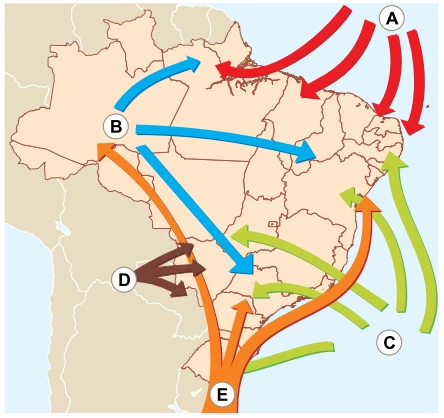
O país passa por uma grave crise econômica caracterizada - FGV 2016
Geografia - 2016O país passa por uma grave crise econômica caracterizada por uma inflação galopante, câmbio descontrolado e sérios problemas de desabastecimento de bens e produtos básicos.
As filas passaram a fazer parte do cotidiano do país. Falta de leite a farinha de milho – base da receita da arepa, um dos principais alimentos da dieta desse país –, de fralda descartável a pasta de dente, de material escolar a medicamentos.
Há, certamente, mais de uma razão para explicar o índice de desabastecimento, que atinge 75% dos produtos monitorados pelo governo, e é quase certo também que ele exercerá uma influência decisiva nas próximas eleições parlamentares.
Há controle oficial de preços, ameaça a setores produtivos, falta de incentivo à indústria, desconfiança do mercado, ausência de crédito e uma série de questões que afetam as produções de bens e produtos. Nenhum grande país produtor de petróleo sentiu o impacto da fortíssima queda das cotações tanto quanto esse país, onde o petróleo responde por 96% das exportações.
A questão climática vem preocupando a comunidade mundial - FGV 2016
Geografia - 2016A questão climática vem preocupando a comunidade mundial nos últimos anos. Criou-se, inclusive, o termo “pegada ecológica”, o rastro deixado por uma comunidade em função de seu índice de consumo, daí derivando os termos “pegada hídrica” e “pegada de carbono”, como se observa no gráfico a seguir.

Observe a caricatura a seguir do líder sírio Bashar al - FGV 2016
Geografia - 2016Observe a caricatura a seguir do líder sírio Bashar al-Assad.
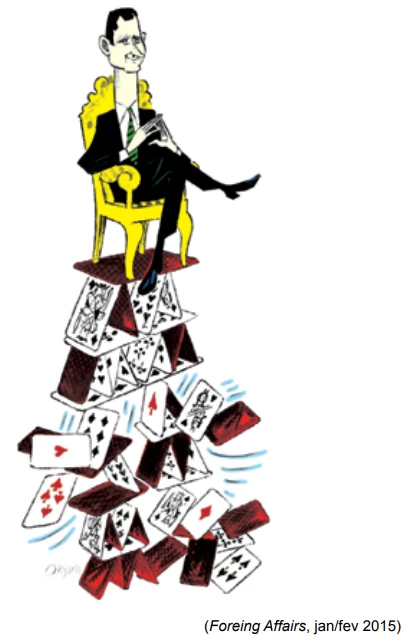
A ANP, Agência Nacional de Petróleo, responsável pela admin - FGV 2016
Geografia - 2016A ANP, Agência Nacional de Petróleo, responsável pela administração das reservas brasileiras de petróleo e gás em regime de monopólio estatal, informa que as jazidas brasileiras estão assim distribuídas:
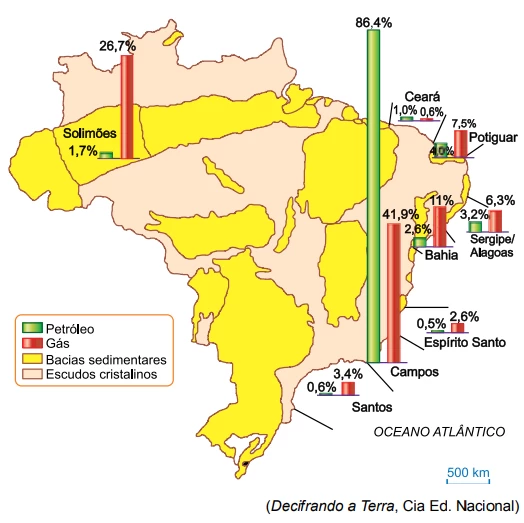
As variações de temperatura ao longo dos dias e noites nas - FGV 2016
Geografia - 2016As variações de temperatura ao longo dos dias e noites nas diferentes estações do ano causam expansão e contração térmica nos materiais rochosos, levando à fragmentação dos grãos minerais. Além disso, os minerais, com diferentes coeficientes de dilatação térmica, comportam-se de forma diferenciada às variações de temperatura, o que provoca deslocamento relativo entre os cristais, rompendo a coesão inicial entre os grãos.
As variações de temperatura ao longo dos dias e noites nas - FGV 2016
Geografia - 2016As variações de temperatura ao longo dos dias e noites nas diferentes estações do ano causam expansão e contração térmica nos materiais rochosos, levando à fragmentação dos grãos minerais. Além disso, os minerais, com diferentes coeficientes de dilatação térmica, comportam-se de forma diferenciada às variações de temperatura, o que provoca deslocamento relativo entre os cristais, rompendo a coesão inicial entre os grãos.
Um dos mais sérios problemas com o qual a Europa se - FGV 2016
Geografia - 2016Um dos mais sérios problemas com o qual a Europa se defronta hoje em dia é a questão migratória. Não que isso seja novidade: ao longo de todo o século XX, a Europa sempre se viu às voltas com grupos que saíam do continente, ou para ele se dirigiam. Porém, atualmente, a migração se tornou uma questão traumática. O mapa a seguir, intitulado “Rotas de Fuga”, mostra os caminhos que os migrantes adotam.

As fotos a seguir mostram cinco diferentes tipos de formaçõ - FGV 2016
Geografia - 2016As fotos a seguir mostram cinco diferentes tipos de formações vegetais presentes nos ambientes brasileiros.

Analise o seguinte pluviograma:
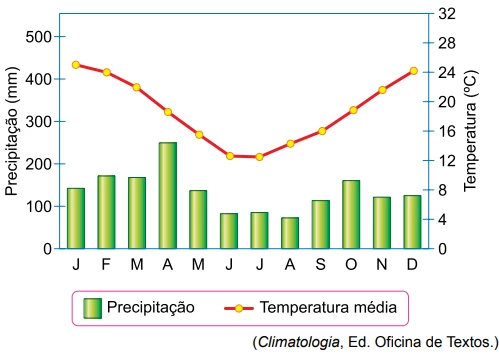
Leia o texto a seguir. O país exportou menos armas em 2014 - FGV 2016
Geografia - 2016Leia o texto a seguir. O país exportou menos armas em 2014. Cortes nos orçamentos de defesa de vários países ocidentais fizeram sistemas bélicos do país cair para US$ 5,7 bilhões – US$ 1 bilhão a menos do que em 2013. Inesperadamente, outro segmento relacionado à segurança ocupou o espaço vazio. Pela primeira vez, vendeu mais softwares de cibersegurança do que armas. Segundo dados divulgados recentemente pela força- -tarefa em cibernética, em 2014, suas empresas faturaram cerca de US$ 6 bilhões com softwares destinados a prover segurança na internet, valor que corresponde a aproximadamente 10% do faturamento mundial do segmento.
Além disso, o país também está produzindo grande quantidade de startups de cibersegurança. Em 2014, oito delas foram vendidas para investidores estrangeiros por um total de US$ 700 milhões.
Nele o número de companhias de cibersegurança dobrou ao longo dos últimos cinco anos. Hoje são 300. A demanda por seus produtos aumentou muito, agora que governos e empresas se deram conta de que precisam se proteger contra os hackers. Esse país dispõe de um contingente considerável de engenheiros de software experientes, oriundos, em sua maioria, de dois importantes mananciais: em primeiro lugar, os quadros de funcionários dos 280 centros de alta tecnologia mantidos no país por multinacionais estrangeiras, de onde saem indivíduos que começam a se lançar em empreendimentos próprios; e, em segundo lugar, as fileiras das forças armadas do país, das quais, todos os anos, são dispensadas centenas de pessoas tecnologicamente capacitadas. Há décadas, os militares vêm desenvolvendo seu arsenal – tanto defensivo quanto ofensivo – para o conflito cibernético, e essa política agora está pagando dividendos.
Considerado uma fonte estratégica para todo o mundo e, - FGV 2016
Geografia - 2016
Considerado uma fonte estratégica para todo o mundo e, principalmente, para o Brasil, o mar vem chamando a atenção de especialistas em energia, que já testam e implantam algumas alternativas de geração, como a usina de ondas. Localizada no quebra-mar do Porto de Pecém, a usina de ondas é a primeira na América Latina responsável pela geração de energia elétrica por meio do movimento das ondas do mar. Com tecnologia 100% nacional, a estimativa é de que o equipamento de baixo impacto ambiental esteja completamente pronto para funcionar até o ano de 2020.
Os anos de bonança para os países produtores e exportadores - FGV 2016
Geografia - 2016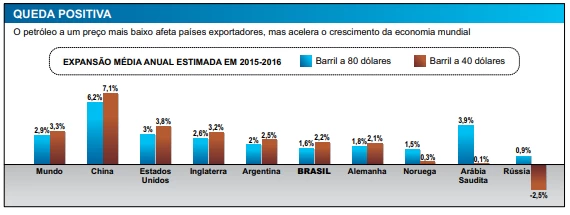
É grande a preocupação com o bloco tanto pelo imobilismo de - FGV 2016
Geografia - 2016É grande a preocupação com o bloco tanto pelo imobilismo de suas regras quanto pelo isolamento em relação aos acordos comerciais. A paralisia do grupo regional e as crescentes medidas protecionistas da Argentina preocupam o setor privado brasileiro, o maior prejudicado por essa situação.
É previsível a continuada oposição da Argentina e da Venezuela à flexibilização das regras do bloco. É do interesse brasileiro ignorar essa oposição e assumir a liderança nas tratativas para retomar os entendimentos com a UE e aceitar a ampliação na negociação externa com países mais desenvolvidos, como o Canadá e a Coreia do Sul. A Espanha defendeu abertamente uma opção pragmática para que as conversações entre a União Europeia e o bloco possam avançar
Paris será a sede, no final de novembro de 2015, da COP-21 - FGV 2016
Geografia - 2016Paris será a sede, no final de novembro de 2015, da COP-21 (Conferência das Partes), em que se buscará a criação do novo acordo climático global para substituir o Protocolo de Kyoto e limitar o aumento na temperatura em 2 °C até 2100.
Em novembro de 2014, Estados Unidos e China haviam fechado acordo para redução das emissões, com metas variáveis entre 2025 e 2050. Os países emergentes, no entanto, cobraram metas mais ambiciosas e claras.
Todos os esforços feitos até agora para criar esboço do novo acordo climático têm esbarrado na divisão de dois blocos: países desenvolvidos e em desenvolvimento. Ambos ainda estão preocupados com as responsabilidades que caberão a cada grupo nas ações para reduzir as emissões de gases do efeito estufa.
Os mapas a seguir mostram, em destaque, a evolução do - FGV 2016
Geografia - 2016Os mapas a seguir mostram, em destaque, a evolução do Império Otomano, que, ao se desfazer na década de 1910, permitiu o surgimento de algumas nações, enquanto outros territórios que lhe pertenciam passaram para o controle colonial de algumas nações imperialistas europeias. Alguns povos tentaram a independência e foram massacrados pelo exército turco. Em um desses massacres, morreram aproximadamente 1,5 milhão de pessoas.
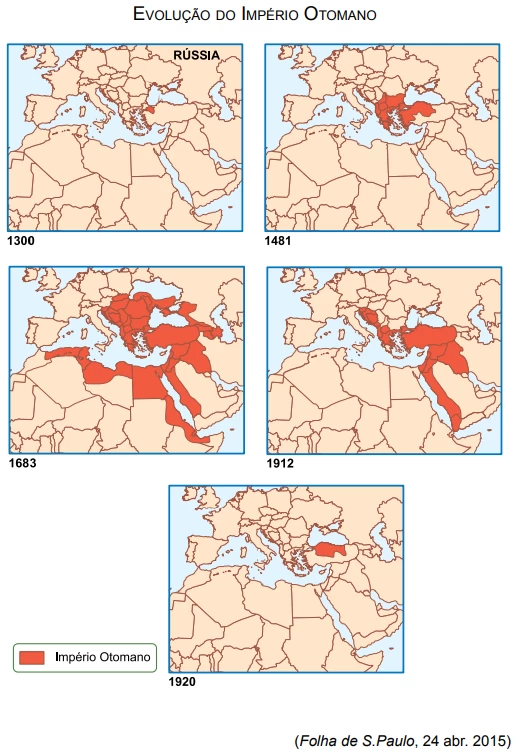
Das sete maravilhas mencionadas pelo grego Antíparo de - FGV 2016
Geografia - 2016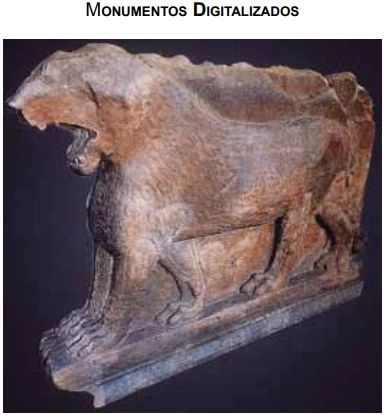
Das sete maravilhas mencionadas pelo grego Antíparo de Sídon há mais de 2100 anos, hoje só se pode conferir uma, a pirâmide egípcia de Quéops. Para que a humanidade não sofra no futuro com o mesmo lapso, arqueólogos e especialistas em impressão 3D criaram o Projeto Mosul. O objetivo é recriar no computador relíquias que estão sendo destruídas pelos terroristas do Estado Islâmico, como um leão do museu de Mosul.
A partir das tabelas e da história brasileira desde os anos - FGV 2016
História - 2016Leia as tabelas.

“(...) eu comecei a defender a tese que me valeu o título - FGV 2016
História - 2016“(...) eu comecei a defender a tese que me valeu o título de golpista e até de fascista. Comecei a defender a tese de que a eleição de outubro de 55 – a sucessão de Café Filho – não poderia ser realizada com a lei eleitoral em vigor, toda cheia de defeitos (...)”
“Ao analisar o mar de contradições em que a Espanha - FGV 2016
História - 2016“Ao analisar o mar de contradições em que a Espanha navegava nas primeiras décadas do século [XX], o filósofo e escritor espanhol Ortega y Gasset diagnosticava os problemas de seu país, usando uma metáfora: era a de uma Espanha invertebrada, sem esqueleto, que se fazia necessário tratar.”
I. “Em Canudos representa de elemento passivo o jagunço que - FGV 2016
História - 2016I.
“Em Canudos representa de elemento passivo o jagunço que corrigindo a loucura mística de Antônio Conselheiro e dando-lhe umas tinturas das questões políticas e sociais do momento, criou, tornou plausível e deu objeto ao conteúdo do delírio, tornando-o capaz de fazer vibrar a nota étnica dos instintos guerreiros, atávicos, mal extintos ou apenas sofreados no meio social híbrido dos nossos sertões, de que o louco como os contagiados são fiéis e legítimas criações. Ali se achavam de fato, admiravelmente realizadas, todas as condições para uma constituição epidêmica de loucura.”
(Nina Rodrigues, As coletividades anormais. 2006)
II.
Ergueu-se contra a República
O bandido mais cruel
Iludindo um grande povo
Com a doutrina infiel
Seu nome era Antônio
Vicente Mendes Maciel
[...]
Os homens mais perversos
De instinto desordeiro
Desertor, ladrão de cavalo
Criminoso e feiticeiro
Vieram engrossar as tropas
Do fanático Conselheiro
O excerto a seguir faz parte do parecer de uma comissão da - FGV 2016
História - 2016O excerto a seguir faz parte do parecer de uma comissão da Câmara dos Deputados sobre a lei de 1871, que discutia a escravidão no Brasil.
“Sem educação nem instrução, embebe-se nos vícios mais próprios do homem não civilizado. Convivendo com gente de raça superior, inocula nela os seus maus hábitos. Sem jus ao produto do trabalho, busca no roubo os meios de satisfação dos apetites. Sem laços de família, procede como inimigo ou estranho à sociedade, que o repele. Vaga Vênus arroja aos maiores excessos aquele ardente sangue líbico; e o concubinato em larga escala é tolerado, quando não animado, facultando-se assim aos jovens de ambos os sexos, para espetáculo doméstico, o mais torpe dos exemplos. Finalmente, com as degradantes cenas da servidão, não pode a mais ilustrada das sociedades deixar de corromper-se.”
Chiquinha Gonzaga alinha-se a outras figuras femininas do - FGV 2016
História - 2016Chiquinha Gonzaga alinha-se a outras figuras femininas do Império (...) como a Imperatriz Leopoldina e Anita Garibaldi. Todas as três, embora de diferentes maneiras, de diferente proveniência social e, em diferentes épocas, desempenharam um papel político que, certamente, contribuiu para as mudanças por elas defendidas e as inscreveu na História do Brasil.
“(...) os homens que naquele momento estavam encarregados - FGV 2016
História - 2016“(...) os homens que naquele momento estavam encarregados de pôr termo à Revolução de 1848 eram precisamente os mesmos que fizeram a de 30. (...)
O que a distinguia ainda, entre todos os acontecimentos que se sucederam nos últimos sessenta anos na França, foi que ela não teve por objetivo mudar a forma, mas alterar a ordem da sociedade. Não foi, para dizer a verdade, uma luta política (...), mas um embate de classe (...).
Havia se assegurado às pessoas pobres que o bem dos ricos era de alguma maneira o produto de um roubo cujas vítimas eram elas (...).
É preciso assinalar ainda que essa insurreição terrível não foi fruto da ação de certo número de conspiradores, mas a sublevação de toda uma população contra outra (...).”
“O gênero humano é de tal ordem que não pode subsistir, a - FGV 2016
História - 2016“O gênero humano é de tal ordem que não pode subsistir, a menos que haja uma grande infinidade de homens úteis que não possuam nada.”
(Dicionário filosófico, verbete Igualdade)
“O comércio, que enriqueceu os cidadãos na Inglaterra, contribuiu para os tornar livres, e essa liberdade deu por sua vez maior expansão ao comércio; daí se formou o poderio do Estado.”
“Caso tomemos o exemplo do Rio de Janeiro (...), iremos - FGV 2016
História - 2016“Caso tomemos o exemplo do Rio de Janeiro (...), iremos perceber de imediato que se trata de uma região caracterizada por forte concentração de riqueza em poucas mãos. Os círculos dos mais ricos – 14% das pessoas – chegaram a ter três quartos da riqueza inventariada. (...) Entre fins do século XVIII e a primeira metade do século XIX, eles chegaram a dominar 95% dos valores transacionados nos empréstimos (...).
Era dentro dessa elite que se situava o pequeno grupo formado pelos negociantes de grande envergadura, cujas fortunas foram constituídas por meio do comércio transoceânico e no comércio colonial de longa distância. (...) Uma vez acumuladas tais fortunas, verifica-se que parte desses homens de negócios (ou seus filhos) abandonava o comércio, convertendo-se em rentistas (pessoas que vivem de rendas, como, por exemplo, do aluguel de imóveis urbanos) ou em grandes senhores de terras e de escravos. Curiosamente, ao fazerem isso, estavam perdendo dinheiro, já que os ganhos do tráfico atlântico de escravos (19% por viagem) eram superiores aos lucros da plantation (de 5% a 10% ao ano).
O que havia por trás de um movimento de reconversão em si mesmo inusitado?”
O poeta canta: “A espada, a cruz e a fome iam dizimando a - FGV 2016
História - 2016O poeta canta:
“A espada, a cruz e a fome iam dizimando a família selvagem.” (Pablo Neruda).
Talvez não seja inútil partir desses versos para tentar perceber por que elementos – que encarados em seu conjunto, constituem um mecanismo – foi possível a conquista da América.
“Só para mim nasceu Dom Quixote, e eu para ele: ele para - FGV 2016
História - 2016“Só para mim nasceu Dom Quixote, e eu para ele: ele para praticar as ações e eu para as escrever (...) a contar com pena de avestruz, grosseira e mal aparada, as façanhas do meu valoroso cavaleiro, porque não é carga para os seus ombros, nem assunto para o seu frio engenho; e a esse advertirás, se acaso chegares a conhecê-lo, que deixe descansar na sepultura os cansados e já apodrecidos ossos de Dom Quixote (...), pois não foi outro o meu intento, senão o de tornar aborrecidas dos homens as fingidas e disparatadas histórias dos livros de cavalarias, que vão já tropeçando com as do meu verdadeiro Dom Quixote, e ainda hão de cair de todo, sem dúvida.”
Leia o documento a seguir. “Não estabeleceremos no nosso - FGV 2016
História - 2016Leia o documento a seguir.
“Não estabeleceremos no nosso reino nenhum subsídio ou escudagem (imposto) sem o consentimento comum do nosso reino (...).
Nenhum homem livre será detido, preso ou privado de seus bens (...) ou levado de qualquer maneira (...) salvo em virtude de um julgamento legal por seus pares (...). A ninguém venderemos, recusaremos (...) o direito ou a justiça. Todos os mercadores poderão livre e seguramente sair da Inglaterra, aí vir e morar e aí passar, por terra ou por mar, para comprar e vender (...)
Instituímos e concedemos aos nossos barões a garantia seguinte: eles elegerão 25 barões de reino, que lhes aprouverem, os quais deverão com todo o seu poder, observar, manter e fazer observar a paz e as liberdades que nós concedemos e confirmamos pela presente carta. (...)”
Considerando-se as informações do mapa e o processo - FGV 2016
História - 2016Analise o mapa.

“Não descreverei catástrofes pessoais de alguns dias - FGV 2016
História - 2016“Não descreverei catástrofes pessoais de alguns dias infelizes, mas a destruição de toda a humanidade, pois é com horror que meu espírito segue o quadro das ruínas da nossa época. Há vinte e poucos anos que, entre Constantinopla e os Alpes Julianos, o sangue romano vem sendo diariamente vertido. A Cítia, Trácia, Macedônia, Tessália, Dardânia, Dácia, Épiro, Dalmácia, Panônia são devastadas pelos godos, sármatas, quedos, alanos (...); deportam e pilham tudo.
Quantas senhoras, quantas virgens consagradas a Deus, quantos homens livres e nobres ficaram na mão dessas bestas! Os bispos são capturados, os padres assassinados, todo tipo de religioso perseguido; as igrejas são demolidas, os cavalos pastam junto aos antigos altares de Cristo (…).”
A imagem da lâmina a seguir mostra um resultado obtido em - FGV 2016
Biologia - 2016A imagem da lâmina a seguir mostra um resultado obtido em teste de tipagem sanguínea humana para os sistemas ABO e Rh. O método consiste, basicamente, em pingar três gotas de sangue da mesma pessoa sobre três gotas de reagentes: anti-A, anti-B e anti-Rh.

O fluxo de água do meio hipotônico para o meio hipertônico - FGV 2016
Biologia - 2016O fluxo de água do meio hipotônico para o meio hipertônico através da membrana lipoproteica semipermeável é denominado osmose, essencial para a manutenção das condições fisiológicas citoplasmáticas em todos os organismos celulares.
Em uma população caracterizada pelo equilíbrio gênico de - FGV 2016
Biologia - 2016Em uma população caracterizada pelo equilíbrio gênico de Hardy-Weinberg, com todos os pressupostos que o tornam válido, a frequência de homozigotos recessivos para um par de alelos autossômicos é 0,49.
A tabela a seguir apresenta, na primeira coluna, quatro - FGV 2016
Biologia - 2016A tabela a seguir apresenta, na primeira coluna, quatro substâncias do sistema digestório humano e, na segunda coluna, as funções dessas substâncias.

Alexander Fleming foi um microbiologista escocês que - FGV 2016
Biologia - 2016Alexander Fleming foi um microbiologista escocês que descobriu a penicilina no ano de 1928, a partir do cultivo não intencional de fungos Penicillium notatum e bactérias Staphylococcus aureus em uma mesma placa de petri. Fleming observou algo bastante semelhante aos testes de antibiograma realizados atualmente
Antibiograma
Na área circular ao redor do antibiótico não ocorre crescimento bacteriano.

A decodificação realizada pelos ribossomos durante a - FGV 2016
Biologia - 2016A decodificação realizada pelos ribossomos durante a síntese de proteínas, tendo por base as informações genéticas contidas na molécula de RNAm,
O gráfico a seguir ilustra o tempo de ação para seis tipos - FGV 2016
Biologia - 2016O gráfico a seguir ilustra o tempo de ação para seis tipos de insulinas clinicamente disponíveis (I a VI), em um período de 24 horas após a aplicação no organismo humano.

A inversão térmica é um fenômeno percebido principalmente - FGV 2016
Biologia - 2016A inversão térmica é um fenômeno percebido principalmente nos grandes centros urbanos durante o período do inverno, resultando em alterações no fluxo vertical das massas de ar quente e fria da atmosfera.
FGV 2016 - No século XIX, Louis Pasteur realizou experimentos utilizan
Biologia - 2016No século XIX, Louis Pasteur realizou experimentos utilizando frascos com e sem pescoços alongados (pescoços de cisne), com o objetivo de compreender a origem da contaminação por micro-organismos em meios de cultura, conforme ilustrado a seguir.

Uma característica genética de uma espécie animal, cuja - FGV 2016
Biologia - 2016Uma característica genética de uma espécie animal, cuja determinação sexual obedece ao sistema XY, é condicionada por um par de alelos autossômicos recessivos. Foram cruzados dois indivíduos heterozigotos para essa característica.
A ureia produzida em indústrias petroquímicas é o - FGV 2016
Biologia - 2016A ureia produzida em indústrias petroquímicas é o fertilizante mais utilizado no mundo pela agricultura convencional como fonte extra de nitrogênio. Já na agricultura orgânica, a qual dispensa o consumo de fertilizantes e defensivos químicos industriais, utiliza-se o esterco animal curtido como fonte suplementar de nitrogênio.
A fotografia seguinte retrata o surgimento de um novo coque - FGV 2016
Biologia - 2016A fotografia seguinte retrata o surgimento de um novo coqueiro a partir de um fruto parcialmente enterrado na areia e disperso pelo mar.
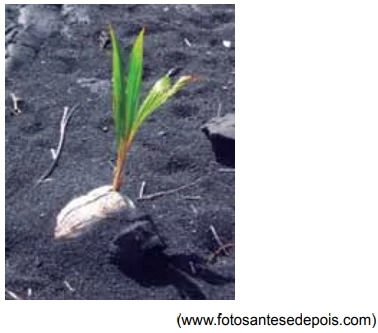
O esquema a seguir ilustra um ciclo celular no qual a - FGV 2016
Biologia - 2016O esquema a seguir ilustra um ciclo celular no qual a célula realiza uma divisão mitótica.

A partenogênese ocorre em óvulos de abelhas rainhas da espé - FGV 2016
Biologia - 2016A partenogênese ocorre em óvulos de abelhas rainhas da espécie Apis mellifera e consiste em óvulos não fecundados que originam novos indivíduos, sempre machos, denominados zangões.
As fêmeas são sempre operárias ou rainhas, formadas a partir da fecundação entre o espermatozoide do zangão e o óvulo da rainha, sendo esta a única fêmea da colmeia cujo sistema reprodutor é desenvolvido.
A figura seguinte ilustra duas organelas celulares - FGV 2016
Biologia - 2016A figura seguinte ilustra duas organelas celulares responsáveis por processos metabólicos essenciais aos seres vivos.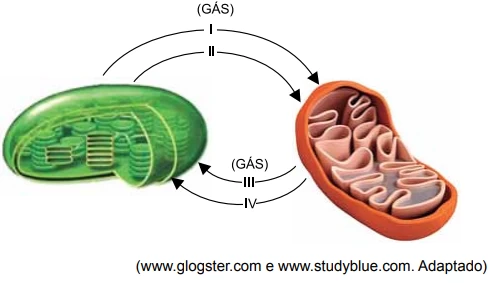
Alfredo e Breno partem, ao mesmo tempo, dos pontos A e B, - FGV 2016
Matemática - 2016Alfredo e Breno partem, ao mesmo tempo, dos pontos A e B, respectivamente, ambos caminhando sobre a reta AB↔, mas em sentidos contrários. No momento em que eles se encontram, Alfredo havia percorrido 18 km a mais do que Breno. Logo depois do encontro, eles continuam suas caminhadas sendo que Alfredo leva 4 horas para chegar em B, percorrendo x quilômetros, e Breno leva 9 horas para chegar em A.
Em uma folha de papel, desenha-se um hexágono regular ABCDE - FGV 2016
Matemática - 2016Em uma folha de papel, desenha-se um hexágono regular ABCDEF de lado 3 cm e inscrito em uma circunferência de centro O. O hexágono é recortado, e, em seguida, faz-se um recorte no raio OB. A partir do recorte no raio, o pedaço de papel será usado para formar uma pirâmide de base quadrangular e centro O. Tal pirâmide será feita com a sobreposição e a colagem dos triângulos OAB e OCD, e dos triângulos OAF e OBC.

O número de pares ordenados (x,y), com x e y inteiros, que - FGV 2016
Matemática - 2016O número de pares ordenados (x,y), com x e y inteiros, que satisfazem a desigualdade x2 + y2; – 8x + 11 ≤ 0
Sendo k um número real, o sistema linear possui infinitas - FGV 2016
Matemática - 2016Sendo k um número real, o sistema linear
A área de um segmento parabólico, sombreado na figura a - FGV 2016
Matemática - 2016A área de um segmento parabólico, sombreado na figura a seguir, pode ser calculada por meio da fórmula

A figura indica um semicírculo de centro C e diâmetro DE = - FGV 2016
Matemática - 2016A figura indica um semicírculo de centro C e diâmetro DE = 24 cm, e um triângulo retângulo ABC. A área sombreada no semicírculo é igual a 69π cm2.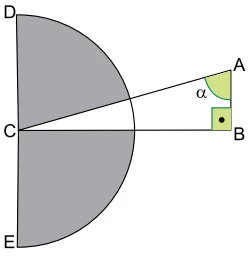
No plano cartesiano, a área do polígono determinado pelo - FGV 2016
Matemática - 2016No plano cartesiano, a área do polígono determinado pelo sistema de inequações
Resolução adaptada de: Curso Objetivo
Em uma rifa, são vendidos 100 bilhetes com números - FGV 2016
Matemática - 2016Em uma rifa, são vendidos 100 bilhetes com números diferentes, sendo que 5 deles estão premiados.
No intervalo de 0 a π, a função que permite calcular a área - FGV 2016
Matemática - 2016No intervalo de 0 a π, a função que permite calcular a área A da região limitada pelo eixo x, pelas retas de equações x = p e x = q e pelo gráfico da função definida por y = sen x é dada por A = cos p – cos q.
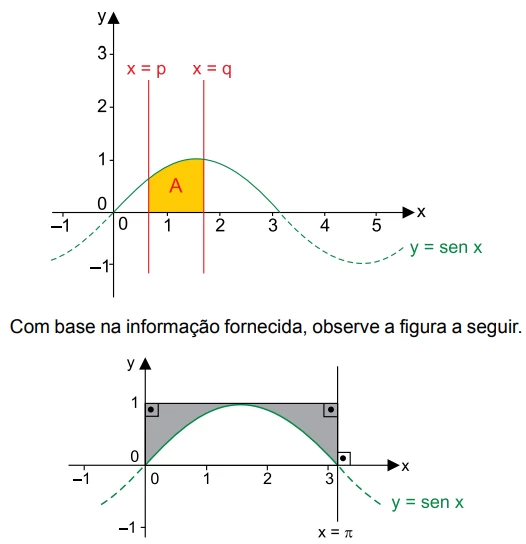
Observe o plano Argand-Gauss a seguir: Observe o plano - FGV 2016
Matemática - 2016Observe o plano Argand-Gauss a seguir: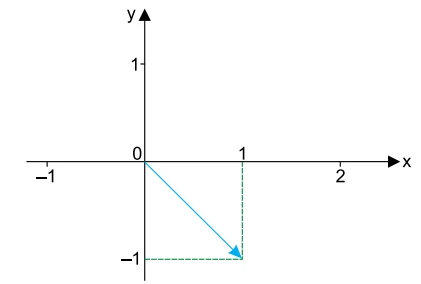
Para 1 < x < y < x+y, seja S = {1, x, y, x + y}. A - FGV 2016
Matemática - 2016Para 1 < x < y < x+y, seja S = {1, x, y, x + y}.
Maria repartiu, entre seus cinco sobrinhos, o seguinte valo - FGV 2016
Matemática - 2016Maria repartiu, entre seus cinco sobrinhos, o seguinte valor monetário: uma moeda de 25 centavos, uma moeda de 50 centavos, uma moeda de 1 real, uma nota de 2 reais e uma nota de 5 reais. Depois de feita a repartição, todos receberam algum valor monetário. A respeito da repartição, Maria e seus sobrinhos fizeram os seguintes comentários:
Aldo: “Recebi a moeda de 1 real”.
Bruno: “Não recebi a nota de 2 reais”.
Cláudio: “Bruno recebeu mais dinheiro do que eu”.
Daniel: “Aldo recebeu a moeda de 50 centavos”.
Eric: “Cláudio não recebeu a nota de 2 reais”.
Maria: “Daniel recebeu menos dinheiro do que Aldo”.
FGV 2016 - Os marcos A, B, C e D de uma cidade estão conectados por
Matemática - 2016Os marcos A, B, C e D de uma cidade estão conectados por pistas de rodagem, conforme mostra a malha viária indicada no diagrama da figura 1. A figura 2 indica uma matriz que representa as quantidades de caminhos possíveis de deslocamento entre os marcos (dois a dois). Considera-se um caminho entre dois marcos qualquer percurso que não viole o sentido da pista, que não passe novamente pelo marco de onde partiu e que termine quando se atinge o marco de destino final pela primeira vez. As flechas da figura 1 indicam o sentido das pistas de rodagem.
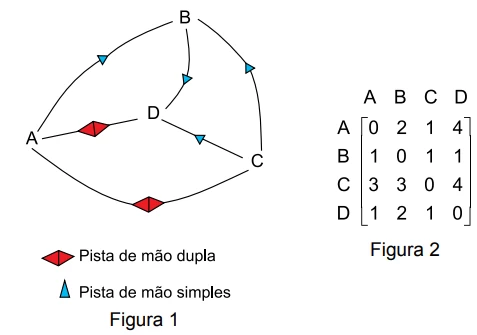
Sendo p e q números reais, com p > q e p + q > 0, definirem - FGV 2016
Matemática - 2016Sendo p e q números reais, com p > q e p + q > 0, definiremos a operação # entre p e q da seguinte forma: p#q = p2 – q2 + log(p + q), com log(p + q) sendo o logaritmo na base 10 de (p + q).
Observe o gráfico da função f no plano cartesiano. Dentre a - FGV 2016
Matemática - 2016Observe o gráfico da função f no plano cartesiano.
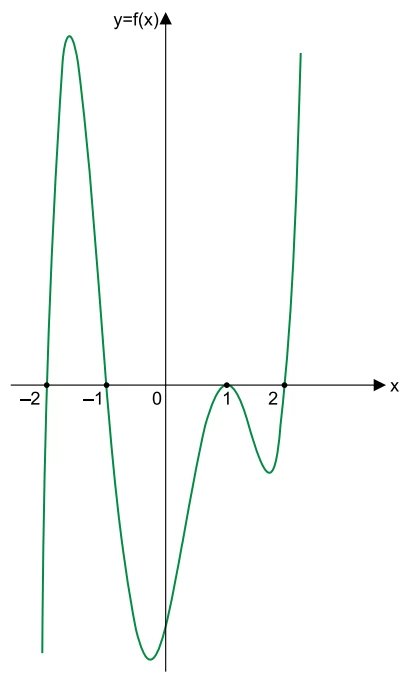
Certa empresa teve seu faturamento anual aumentado de R$ 80 - FGV 2016
Matemática - 2016Certa empresa teve seu faturamento anual aumentado de R$ 80.000,00 para R$ 400.000,00 em três anos. Se o faturamento cresceu a uma mesma taxa anual nesse período,
A equação algébrica ax3 + bx2 + cx + d = 0 possui - FGV 2016
Matemática - 2016A equação algébrica axl3 + bx2 + cx + d = 0 possui coeficientes reais a, b, c, d, todos não nulos. Sendo x1 , x2 e x3 as raízes dessa equação, então
O produto é igual a (A) 2014–1 (B) 2015–1 (C) (2014.2015)–1 - FGV 2016
Matemática - 2016O produto
Sabendo-se que o resto da divisão do polinômio P(x) = x3 - FGV 2016
Matemática - 2016Sabendo-se que o resto da divisão do polinômio P(x) = x3 – x2 + 2k + 2 por x – 3 é igual a 4k – 220,
Na figura seguinte, as retas r e s são paralelas entre si, - FGV 2016
Matemática - 2016Na figura seguinte, as retas r e s são paralelas entre si, e perpendiculares à reta t. Sabe-se, ainda, que AB = 6 cm, CD = 3 cm, AC é perpendicular a CD, e a medida do ângulo entre CD e a reta s é 30°.
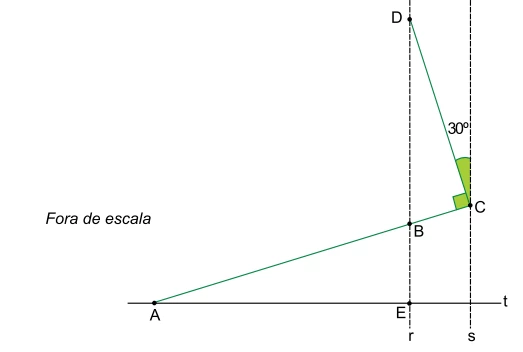
O domínio da função real definida por é {x ∈ IR / m ≤ x ≤ n - FGV 2016
Matemática - 2016O domínio da função real definida por {x ∈ IR / m ≤ x ≤ n}.
{x ∈ IR / m ≤ x ≤ n}.
No plano cartesiano, a equação da reta tangente ao gráfico - FGV 2016
Matemática - 2016No plano cartesiano, a equação da reta tangente ao gráfico de x2 + y2 = 25
As cordas AB e CD de uma circunferência de centro O são - FGV 2016
Matemática - 2016As cordas AB e CD de uma circunferência de centro O são, respectivamente, lados de polígonos regulares de 6 e 10 lados inscritos nessa circunferência. Na mesma circunferência, as cordas AD e BC se intersectam no ponto P, conforme indica a figura a seguir.

André e Bianca estão juntos no centro de um campo plano de - FGV 2016
Matemática - 2016André e Bianca estão juntos no centro de um campo plano de futebol quando iniciam uma caminhada em linha reta de 10 metros (cada um) na mesma direção, mas em sentidos contrários. Depois dessa caminhada, André lança uma moeda honesta e, se der cara, gira 90° para a direita e caminha mais 10 metros em linha reta, na direção e no sentido para os quais está voltado; se der coroa, gira 90° para a esquerda e caminha mais 10 metros em linha reta, na direção e no sentido para os quais está voltado. Bianca faz o mesmo que André. Depois dessa segunda caminhada de ambos, André e Bianca repetem o mesmo procedimento em uma terceira caminhada de 10 metros.
O resto da divisão do número 62015 por 10 é igual a a) 4. - FGV 2016
Matemática - 2016O resto da divisão do número 62015
Três números formam uma progressão geométrica. A média - FGV 2016
Matemática - 2016Três números formam uma progressão geométrica. A média aritmética dos dois primeiros é 6, e a do segundo com o terceiro é 18.
O triângulo ABC possui medidas conforme indica a figura a - FGV 2016
Matemática - 2016O triângulo ABC possui medidas conforme indica a figura a seguir.
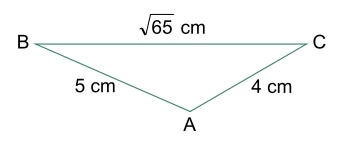
Um professor de matemática aplica três provas em seu curso - FGV 2016
Matemática - 2016Um professor de matemática aplica três provas em seu curso (P1, P2, P3), cada uma valendo de 0 a 10 pontos. A nota final do aluno é a média aritmética ponderada das três provas, sendo que o peso da prova Pn é igual a n2. Para ser aprovado na matéria, o aluno tem que ter nota final maior ou igual a 5,4.
Na reta numérica indicada a seguir, todos os pontos marcado - FGV 2016
Matemática - 2016Na reta numérica indicada a seguir, todos os pontos marcados estão igualmente espaçados.

De acordo com matéria da revista The Economist divulgada - FGV 2016
Matemática - 2016De acordo com matéria da revista The Economist divulgada em 2014, o Brasil tem o quinto Big Mac mais caro do mundo, ao preço de US$ 5,86. A mesma matéria aponta o preço do Big Mac nos EUA (US$ 4,80) como o décimo quarto mais caro do mundo. Se usássemos o preço do Big Mac nos EUA (em US$) como referência de preço, então o preço do Big Mac no Brasil (em US$) supera o dos EUA em, aproximadamente,
No trecho do texto “1.5 million children die each year - FAMERP 2016
Inglês - 2016Leia o texto para responder às questões de 78 a 80.
W.H.O. calls ‘vaccine hesitancy’
an increasing concern globally
Rick GladstoneAugust 18, 2015
The World Health Organization warned Tuesday of what it called the growing problem of “vaccine hesitancy,” when people delay or refuse vaccines for themselves or their children. In a statement on its website, the organization called the problem “a growing challenge for countries seeking to close the immunization gap.” Globally, the organization said, one in five children still do not receive routine lifesaving immunizations, and 1.5 million children die each year of diseases that could have been thwarted by vaccines.
(www.nytimes.com)
Apoie nosso trabalho!
Assine Agora